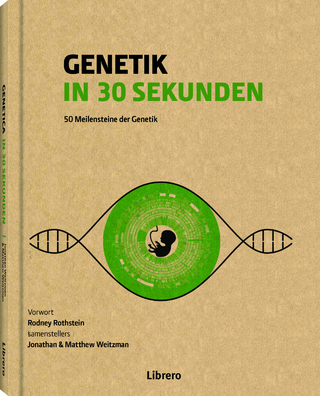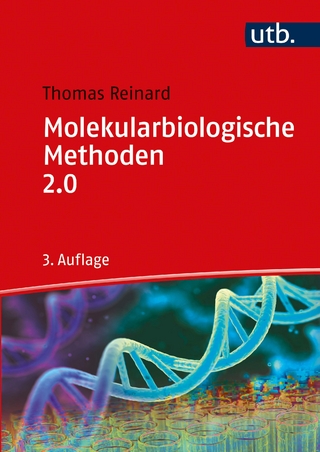
Stem Cells in Birth Defects Research and Developmental Toxicology
John Wiley & Sons Inc (Verlag)
978-1-119-28321-8 (ISBN)
Provides important platforms and contemporary accounts of the state of stem cell research in the fields of toxicology and teratology
Considers both in vitro uses of stem cells as platforms for teratology and also stem cellopathies, which are in vivo developmental and degenerative disorders
Helps the pharmaceutical industry and safety and environmental authorities validate the status quo of in vitro toxicity test systems based on human pluripotent stem cells and their derivatives
Theodore P. Rasmussen, PhD is an Associate Professor in the Department of Pharmaceutical Sciences at the University of Connecticut, a charter member of the school's Stem Cell Institute, and a founding member of the university's Institute for Systems Genomics.
List of Contributors xiii
Preface xix
Part I Introduction and Overview 1
1 The Basics of Stem Cells and Their Utility as Platforms to Model Teratogen Action and Human Developmental and Degenerative Disorders 3
Bindu Prabhakar, Soowan Lee, and Theodore P. Rasmussen
1.1 Stem Cell Types and Basic Function 3
1.2 Pluripotency 6
1.2.1 Poised Chromatin of the Pluripotent Epigenome 6
1.2.2 Undirected Differentiation of Pluripotent Cells to Embryoid Bodies 7
1.2.3 Directed Differentiation of Pluripotent Cells 8
1.3 In vitro Uses of Pluripotent Cells 9
1.3.1 Pluripotent Cells for Toxicology 9
1.3.2 Pluripotent Cells for Teratology 11
1.3.3 Limitations of Pluripotent Stem Cells 12
1.4 Adult Stem Cells in vivo 13
1.5 Emerging Trends in Stem Cell Culture 14
1.5.1 Use of Coculture 15
1.5.2 Organoids 16
1.5.3 Microfluidics 17
1.5.4 Other Cell Types with Stem-Cell-like Properties 18
1.6 Future Directions 18
1.6.1 iPSCs, Pharmacogenomics, and Predictive Teratology 18
1.6.2 Stem Cell Systems for Environmental Toxicology 19
References 20
Part II Using Pluripotent Cells for the Detection and Analysis of Teratogens 25
2 Stem Cells and Tissue Engineering Technologies for Advancing Human Teratogen Screening 27
Jiangwa Xing, Geetika Sahni, and Yi-Chin Toh
Abbreviations 27
2.1 Introduction 28
2.2 Current DART Regulatory Guidelines and Methods 29
2.2.1 Governing Bodies 29
2.2.2 Terminologies and Definitions 29
2.2.3 Testing Methodologies 30
2.2.4 Limitations of Animal-Based DART Testing 32
2.3 In vitro Animal-Based Models for Developmental Toxicity Testing 33
2.3.1 Current In vitro Animal-Based Models for Developmental Toxicity Testing 33
2.3.2 The MM Assay 35
2.3.3 The WEC Assay 35
2.3.4 The ZEDT Assay 36
2.3.5 New Engineering and Microfabrication Technologies for Model Improvement 38
2.4 In vitro Stem-Cell-Based Developmental Toxicity Models 42
2.4.1 Embryonic Stem Cell Test (EST) 42
2.4.2 ReproGlo Reporter Assay 45
2.4.3 Metabolite Biomarker Assay Using hESCs 46
2.4.4 Mesoendoderm Biomarker-Based Human Pluripotent Stem Cell Test (hPST) 47
2.4.5 The Micropatterned Human Pluripotent Stem Cell Test(μP-hPST) 48
2.5 Conclusion and Future Directions 50
References 51
3 Use of Embryoid Bodies for the Detection of Teratogens and Analysis of Teratogenic Mechanisms 59
Anthony Flamier
3.1 Embryoid Body Assays: Background 59
3.1.1 Teratogens and Teratogenesis 59
3.1.2 Classic Protocols for Teratogen Assays 60
3.1.3 Pluripotent Stem Cell Technology and its Applications for Teratogen Detection 62
3.2 Detection of Teratogens Using EBs 63
3.2.1 Formation of Embryoid Bodies for Teratogen Assays 63
3.2.2 Cytotoxicity versus Teratogenicity 65
3.2.3 EB Treatments 65
3.3 Teratogenic Mechanisms 65
3.3.1 EB Growth and Morphogenesis 65
3.3.2 Molecular Analysis 66
3.3.3 Alternative Analyses 67
Acknowledgments 67
References 67
4 Stem-Cell-Based In vitro Morphogenesis Models to Investigate Developmental Toxicity of Chemical Exposures 71
Yusuke Marikawa
4.1 Introduction 71
4.2 Stem-Cell-Based In vitro Morphogenesis Model 73
4.2.1 Mouse P19C5 EB as an In vitro Gastrulation Model 73
4.2.2 Quantitative Evaluation of Morphogenetic Impact 77
4.2.3 Detection of Developmentally Toxic Exposures Using Morphometric Analyses 78
4.2.4 Investigations into the Molecular Mechanisms of Teratogen Actions Using P19C5 EBs 81
4.3 Future Directions: Enhancing Morphogenesis-Based Assays 83
4.3.1 Analyses of Changes in Gene Expression Relevant for Teratogenesis 83
4.3.2 Detection of Proteratogens Using Metabolic Systems 84
4.3.3 Representation of Additional Developmental Regulator Signals 84
4.3.4 Recapitulation of Human Embryogenesis Using Human Embryonic Stem Cells 85
4.4 Concluding Remarks 85
Acknowledgment 86
References 86
5 Risk Assessment Using Human Pluripotent Stem Cells: Recent Advances in Developmental Toxicity Screens 91
Kristen Buck and Nicole I. zur Nieden
5.1 Introduction 91
5.2 Animal Embryo Studies to Evaluate Developmental Toxicity 91
5.3 Usage of Mouse Embryonic Stem Cells in Developmental Toxicity 94
5.4 Alternative Endpoint Read-Out Approaches in the EST 96
5.4.1 Simple and Complex Methods – Trends Are Ever Changing 96
5.4.2 Genomics, Transcriptomics, Proteomics, and Metabolomics 98
5.5 Novel Methods and Protocols to Replicate Human Development 99
5.5.1 Human Embryonic Stem Cells 100
5.5.2 Multipotent Stem Cells and Beyond 103
5.6 Future Applications 105
Acknowledgments 105
References 106
Part III Human Developmental Pathologies Mediated
by Adult Stem Cells 119
6 Modeling the Brain in the Culture Dish: Advancements and Applications of Induced Pluripotent Stem-Cell-Derived Neurons 121
Sandhya Chandrasekaran, Prashanth Rajarajan, Schahram Akbarian, and Kristen Brennand
6.1 Introduction 121
6.2 Methods to Generate Patient-Derived Neurons 122
6.2.1 Directed Differentiation of Neurons from Pluripotent Stem Cells 122
6.2.2 Dopaminergic Neurons 123
6.2.3 Glutamatergic Neurons 123
6.2.4 GABAergic Interneurons 124
6.2.5 Striatal Neurons 125
6.2.6 Other Neurons (Serotonergic and Motor) 126
6.2.7 Limitations of Directed Differentiation 127
6.3 Neuronal Induction from Fibroblasts and hiPSCs 127
6.3.1 Induced Neurons (iNeurons) 128
6.3.2 Dopaminergic iNeurons 129
6.3.3 Glutamatergic iNeurons 130
6.3.4 Induced GABAergic Interneurons 130
6.3.5 Induced Medium Spiny Neurons 131
6.3.6 Serotonergic iNeurons 131
6.3.7 Induced Motor Neurons 131
6.3.8 Limitations of Neuronal Induction 132
6.4 Cerebral Organoids: Neural Modeling in Three Dimensions 132
6.4.1 Current Methods for Deriving Cerebral Organoids 132
6.4.2 Applications of Cerebral Organoids: Disease Modeling 134
6.4.3 Limitations in the Use of Cerebral Organoids 135
6.5 Epigenetic Considerations in hiPSC Donor Cell Choice 136
6.6 Aging Neurons 137
6.6.1 Techniques to Age hiPSCs 137
6.6.2 Aging and Dedifferentiation 138
6.6.3 Future Directions 139
6.7 Drug Testing Using hiPSCs 140
6.7.1 Facilitating Clinical Trials 140
6.7.2 Titrating Drug Dosage 140
6.7.3 Evaluating Chemotherapies 141
6.7.4 Steering Personalized Medicine 141
6.7.5 Forging Neural Networks 142
6.8 Promises in the Field 142
6.8.1 High-Throughput Automation 142
6.8.2 Neural Tissue Engineering Using hiPSCs 142
6.8.3 hiPSC-Based Transplantation Therapies 143
6.8.4 Advances Using Gene-Editing Technologies 144
6.9 Concluding Remarks 145
References 146
7 Modeling Genetic and Environment Interactions Relevant to Huntington’s and Parkinson’s Disease in Human Induced Pluripotent Stem Cells (hiPSCs)-Derived Neurons 159
Piyush Joshi, M. Diana Neely, and Aaron B. Bowman
7.1 Gene–Environment Interactions Assessed in hiPSC-Derived Neurons 159
7.2 Modeling of Neurological Diseases with hiPSCs 160
7.3 Cell Viability Assays 162
7.4 Mitochondria 163
7.5 Oxidative Stress 164
7.6 Neurite Length by Immunocytochemistry (ICC) 164
7.7 Conclusions 166
References 167
8 Alcohol Effects on Adult Neural Stem Cells – A Novel Mechanism of Neurotoxicity and Recovery in Alcohol Use Disorders 173
Rachael A. Olsufka, Hui Peng, Jessica S. Newton, and Kimberly Nixon
8.1 Introduction 173
8.2 The “Birth” of the Study of “Neuronal Cell Birth” 175
8.3 Components of Adult Stem-Cell-Driven Neurogenesis 180
8.3.1 Permissive Sites of Adult Neurogenesis in Brain 180
8.3.2 Stem Cells Versus Progenitors 182
8.3.3 Proliferation 184
8.3.4 Differentiation and Migration 187
8.3.5 Cell Survival and Integration 188
8.4 Alcohol Effects on Adult Neural Stem Cells and Neurogenesis 189
8.4.1 Proliferation 189
8.4.2 Differentiation and Migration 193
8.4.3 Survival and Integration 194
8.5 Extrinsic Factors Influence the Neurogenic Niche 196
8.6 Alcohol and the Niche 198
8.7 Conclusions 200
References 201
9 Fetal Alcohol Spectrum Disorders: A Stem-Cellopathy? 223
Amanda H. Mahnke, Nihal A. Salem, Alexander M. Tseng, Annette S. Fincher, Andrew Klopfer, and Rajesh C. Miranda
9.1 Fetal Alcohol Spectrum Disorders 223
9.2 Stem Cells 225
9.2.1 Totipotent Stem Cells 227
9.2.2 Placental Stem Cells – Trophoblast 230
9.2.3 Embryonic Stem Cells and Induced Pluripotent Stem Cells 231
9.3 Endoderm 234
9.3.1 Liver 234
9.4 Mesoderm 235
9.4.1 Cardiac Development 235
9.4.2 Kidney 237
9.5 Ectoderm 238
9.5.1 Neuroectoderm Development 238
9.5.2 Neural Crest 239
9.5.3 Neural Tube Development 240
9.6 Future Directions 243
9.6.1 Fetal Origin of Adult Stem Cells 243
9.6.2 Sex Differences 244
9.6.3 Stem Cell Therapy 245
9.7 Conclusion 245
References 246
10 Toxicological Responses in Keratinocyte Interfollicular Stem Cells 261
Rambon Shamilov and Brian J. Aneskievich
10.1 Epidermal Keratinocyte Stem Cells 261
10.2 Arsenic 267
10.3 Dioxin 269
10.4 Bacterial Toxins 273
10.5 Conclusions and Prospective Considerations 274
References 275
Part IV Recent Innovations in Stem Cell Bioassay and Platform Development 285
11 Stem-Cell Microscale Platforms for Toxicology Screening 287
Tiago G. Fernandes and Joaquim M. S. Cabral
11.1 Introduction 287
11.2 Stem Cell Models for Toxicology Assessment 288
11.3 Biomimetic Microscale Systems for Drug Screening 290
11.3.1 Design and Microfabrication: Soft Lithography and Replica Molding 290
11.3.2 Microcontact Printing and Surface Patterning 292
11.3.3 Robotic Spotting and Printing 292
11.4 Microtechnologies for Drug Discovery 293
11.5 Devices for High-Throughput Toxicology Studies 294
11.6 Cellular Microarray Platforms 295
11.7 Microfluidic Platforms 298
11.8 Conclusions and Future Perspectives 301
Acknowledgments 301
References 302
12 HepaRG Cells as a Model for Hepatotoxicity Studies 309
André Guillouzo and Christiane Guguen-Guillouzo
12.1 Introduction 309
12.2 Characteristics of HepaRG Cells 310
12.2.1 A Bipotent Human Liver Cell Line 310
12.2.2 HepaRG Hepatocytes Express Liver-Specific Functions 314
12.2.1 Long-Term Functional Stability of HepaRG Hepatocytes 315
12.3 Biotransformation and Detoxification Activities 316
12.3.1 Drug Metabolism Capacity 316
12.3.2 Biokinetics and Intrinsic Clearances 318
12.3.3 Applications 319
12.4 Toxicity Studies 320
12.4.1 Hepatotoxicity Screening 320
12.4.2 Cellular Cytotoxicity 322
12.4.3 Genotoxicity and Carcinogenicity Screening 324
12.4.1 Identification of Target Genes 325
12.4.2 Cholestasis 326
12.4.3 Steatosis 327
12.4.4 Phospholipidosis 328
12.5 Conclusions and Perspectives 328
Acknowledgments 329
References 330
Index 341
| Erscheinungsdatum | 28.07.2018 |
|---|---|
| Verlagsort | New York |
| Sprache | englisch |
| Maße | 158 x 231 mm |
| Gewicht | 771 g |
| Themenwelt | Naturwissenschaften ► Biologie ► Genetik / Molekularbiologie |
| Naturwissenschaften ► Chemie | |
| Technik ► Umwelttechnik / Biotechnologie | |
| ISBN-10 | 1-119-28321-3 / 1119283213 |
| ISBN-13 | 978-1-119-28321-8 / 9781119283218 |
| Zustand | Neuware |
| Informationen gemäß Produktsicherheitsverordnung (GPSR) | |
| Haben Sie eine Frage zum Produkt? |
aus dem Bereich


